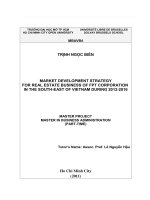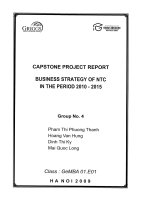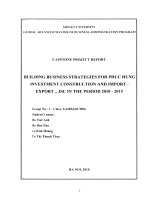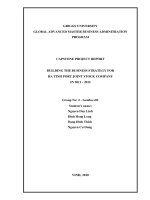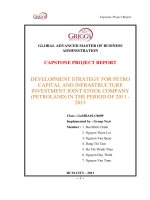Building the Development Strategy for the Hochiminh city Electric Power College in the period 2010 - 2015
Bạn đang xem bản rút gọn của tài liệu. Xem và tải ngay bản đầy đủ của tài liệu tại đây (1.69 MB, 151 trang )
Building the Development Strategy
for the Hochiminh city Electric Power College
in the period 2010 - 2015
CAPSTONE PROJECT REPORT
HO CHI MINH CITY, 2010
Group 11:
Le Viet Bac
Nguyen Kim Thom
Bui Quoc Viet
Vu Tuan Quynh
GeMBA01.E04
CAPSTONE PROJECT REPORT
I
E04.Strategic Management.Group 11
GRIGGS UNIVERSITY
GLOBAL ADVANCED MASTER OF BUSINESS ADMINISTRATION PROGRAM
CAPSTONE PROJECT REPORT
BUILDING THE DEVELOPMENT STRATEGY OF
HO CHI MINH CITY ELECTRIC POWER COLLEGE
PERIOD 2010 - 2015
Group No.: 11
1. Vu Tuan Quynh (Group leader)
2. Le Viet Bac
3. Nguyen Kim Thom
4. Bui Quoc Viet
Class: GeMBA01.E04
HO CHI MINH CITY, 2010
GeMBA01.E04
CAPSTONE PROJECT REPORT
II
E04.Strategic Management.Group 11
INTRODUCTION
After serious study in the training program Master of Business Administration
International (abbreviations as GaMBA) Technology Center of Training and
Employment System - Hanoi National University associated Griggs University -
United States training institutions in Vietnam. This stage to make great graduation
exercises, Our group of 11 - Class GeMBA01.E04 (study at Ho Chi Minh city) have
4 members.
No
Full name
Gender
Position
Company
1
Vu Tuan Quynh
Male
Manager of
Network Faculty
Ho Chi Minh city
Electricity Power
College
2
Le Viet Bac
Male
Director
Information
Technology centre
(Branch in Southern)
3
Nguyen Kim Thom
Female
Deputy Manager
of Training Dept.
Ho Chi Minh city
Electricity Power
College
4
Bui Quoc Viet
Male
Chief Accountant
An Binh bank
(Ho Chi Minh city)
Together to build theme: "Building the development strategy of the Ho Chi
Minh city Electric Power College in period 2010 – 2015”.
For education, strategy and strategic management help schools especially
universities and colleges to satisfy the maximum demand of human resources for
society, improving qualifications, and ability to train in conditions self-limited and
ensure lives of staff - teachers – employees.
GeMBA01.E04
CAPSTONE PROJECT REPORT
III
E04.Strategic Management.Group 11
Wishing to contribute to building a strategy for school operations effectively,
to enhance competitiveness, vitality and continuous development, major exercises,
including graduates of our 03 chapters:
Chapter 1: Systematic theoretical basis of strategic planning
Chapter 2: Analysis of the operating environment of HEPC
Chapter 3: The solution strategies for HEPC development period from 2010 to
2015.
Thank to the lecturer; members of the specialist; managing board; The Office
and Departments helped us finish this great good exercise.
GeMBA01.E04
CAPSTONE PROJECT REPORT
IV
E04.Strategic Management.Group 11
OVERVIEW OF THE CAPSTONE PROJECT REPORT
1. Objective
Ho Chi Minh City Electric Power
College is previously known as Gia Dinh
Engineering College. According to Decision
No. 5314/QD-BGD&DT, dated 21
st
May
2005, by the Minister of Education and
Training, the college was upgraded and
renamed the Ho Chi Minh city Electricity
College.
Ho Chi Minh City Electricity College a
unit attached to the Electricity of Vietnam. The main tasks of the college are
training technicians and secondary level to satisfy labor demand in electricity sector
in the South of Vietnam. During this time, Vietnam trend is along with the
development of the economy - our country towards international integration and
advocated the socialization of education and training sector in Vietnam change to
competitive market. Many training institutions during the year with more training
curriculum modern, advanced to meet the needs of society and the students
themselves. Increasing numbers of special training establishments are foreign
elements.
As a result, the college needs to develop strategy effectively to enhance
competitiveness, survival and continuous development. Wishing to contribute to
building a strategy for college development, we carry out a research with the title:
"Building the development strategy of Ho Chi Minh city Electricity Power
College period 2010 - 2015”
2. Research objectives:
- Theoretical systematic for strategy development
- Activity environment analysis of Ho Chi Minh City Electricity Power College
- Development orientation for the college in 2010 – 2015
GeMBA01.E04
CAPSTONE PROJECT REPORT
V
E04.Strategic Management.Group 11
3. Research results
- Take out targets and tasks for strategy development of the college by year 2015
- Propose some solutions and recommendations to implement effectively strategy
4. Scope of research
- Environment factors of activities in the College
- The education and training activities of other training institutions operating in the
same field in the south Vietnam.
5. Methodology
- Based on the theory of business management, the method of synthesis, statistic
and analysis is applied.
- In this study, sources of data is collected from the office of Ho Chi Minh city
Electricity College, from the official information of Vietnam government, and
other domestic as well as foreign research and studies on education and training
field.
6. Research content
In the context of the current market, college can grow further in scale and
quality of training .Thus, there is a need to prepare both theory and practical in
order to help the College develop to a higher position.
Besides the opening – conclusions and recommendations parts, this study
includes three chapters:
- Chapter 1: Establishment of general reasoning strategy development and strategic
activities of the College – University
- Chapter 2: Analyzing the HEPC reality situation in recent years.
- Chapter 3: Building strategic development of Ho Chi Minh city Electric Power
College period 2010 – 2015
GeMBA01.E04
CAPSTONE PROJECT REPORT
VI
E04.Strategic Management.Group 11
ABBREVIATION
EVN
GD&ĐT
LĐ-TB&XH
HCMC
HEPC
IFE
EFE
SWOT
Electricity of Vietnam
Education and Training
Labor, Invalids and Social Affairs
Ho Chi Minh City
Ho Chi Minh city Electricity Power College
Internal Factors Evaluation matrix
External Factors Evaluation matrix
SWOT matrix
LIST OF TABLE
Page
Table 1.1: Macro environment factors
Table 1.2: Environmental impact evaluation
Table 1.3: SWOT matrix
08
11
14
Table 2.1: Human resource in each department and faculty
Table 2.2: Structure of teaching staff in each professional department
Table 2.3: Teaching staff in HEPC
Table 2.4: Training field of HEPC
Table 2.5: Training scale in HEPC period 2006 – 2009
Table 2.6: Quantity of researching themes in HEPC period 2005 – 2009
Table 2.7: Quantity and classification of books in HEPC library
Table 2.8: Major revenue sources of HEPC
Table 2.9: Construction area
Table 2.10: Internal Factor Evaluation matrix (IFE)
26
27
28
30
31
37
39
40
41
49
GeMBA01.E04
CAPSTONE PROJECT REPORT
VII
E04.Strategic Management.Group 11
Table 2.11: Training and development plan of EVN human resources to
2015
Table 2.12: Population of Viet Nam period 2001- 2008
Table 2.13: The training industries and specialized field of universities
and colleges
Table 2.14: Compared with the size of a typical Universities
Table 2.15: Expenses for study of the types of training
Table 2.16: External Factor Evaluation matrix (EFE)
Table 2.17: Summary of strengths, weaknesses, opportunities and
threats of HEPC
54
57
65
66
68
69
71
Table 3.1: Strengths - Weaknesses - Opportunities – Threats
of the Ho Chi Minh city Electric Power College
Table 3.2: SWOT matrix
Table 3.3: Formation of development strategic plans.
Table 3.4: QSPM matrix for SO strategies
Table 3.5: QSPM matrix for ST strategies
Table 3.6: QSPM matrix for WT strategies
Table 3.7: Develop training scale period 2010 – 2015
Table 3.8: Development of teacher and lecturer team period 2010-2015
Table 3.9: Roadmap recruitment of teachers / lecturers 2015
Table 3.10: Number of teachers/lecturers sends to study annual
training plan
Table 3.11: Plan funding for training and development team
Table 3.12: Diversification of industry training
Table 3.13: Plan funding for training, retraining and improve
the teachers, lecturers and staffs
Table 3.14: Plan of expenditure
80
81
82
84
86
87
94
97
99
100
100
101
105
107
GeMBA01.E04
CAPSTONE PROJECT REPORT
VIII
E04.Strategic Management.Group 11
LIST OF FIGURE
Page
Figure 1.1: Strategy decisions
Figure 1.2: Relationship of five tasks management strategy
Figure 1.3: The process of comprehensive strategic management
by Fred R. David
Figure 1.4: The factors that constitute the environment of the organization
Figure 1.5: The competitive advantage
2
4
5
7
10
Figure 2.1: Logo of the Ho Chi Minh city Electric Power College
Figure 2.2: Structure of HEPC organization
Figure 2.3: Analysis of HEPC internal environment
Figure 2.4: Structure of human resource in HEPC
Figure 2.5: Teaching staff in HEPC
Figure 2.6: HEPC’s training scale period 2006 – 2009
Figure 2.7: The HEPC revenue sources (without EVN fund)
Figure 2.8: Students perform exercises on the LV -HV practical site
Figure 2.9: Model of facility project – campus 1
Figure 2.10: Model of HEPC facility project – Campus 2
Figure 2.11: The ratio of the customers training demand (%)
Figure 2.12: The customer’s ideas about Strengths, weaknesses,
opportunities, threats of HEPC
(The ratio of completely agreement %)
21
24
25
26
28
32
40
43
46
47
64
73
Figure 3.1 a: Model combines internal and external environmental factors
Figure 3.1 b: The sources establish the competitive advantages
Figure 3.1: Forecasting the training scale (Regular training)
Figure 3.2: Forecasting the training scale (In-service training)
Figure 3.3:Development of teachers and lecturers period 2010 - 2015
Gantt diagrams for the diversification process of new training industry
82
93
95
95
98
118
GeMBA01.E04
CAPSTONE PROJECT REPORT
IX
E04.Strategic Management.Group 11
CONTENT
STATEMENT – INTRODUCTION – OVERVIEW …………………I – X
ABBREVIATION – LIST OF TABLE – LIST OF FIGURE ……… XI – XIII
CONTENT…………………………………………………………… XIV – XVI
Chapter 1: GENERAL STRATEGY THEORY AND STRATEGY
DEVELOPMENT OF COLLEGE … 1
1.1 Strategy overview 1
1.1.1 Strategy concept 1
1.1.2 The concept of strategic management 4
1.1.3 Process of strategic management 5
1.1.4 Strategy types and strategic management 6
1.2 Some features of educational activities 17
1.2.1 Features of educational in Viet Nam ……………………………. 17
1.2.2 The matters are interested in building the college strategies … 18
1.3 Summary 21
Chapter 2: CURRENT SITUATION OF HO CHI MINH CITY
POWER COLLEGE 22
2.1 Introduction of Ho Chi Minh city Power College 22
2.1.1 Name - Logo 22
2.1.2 Contact address 22
2.1.3 Establishment and development ……….…………………… 22
2.1.4 Functions and tasks ……………………….……… 23
2.1.5 Structure of organization …… 24
2.2 Analysis of HEPC internal environment factors 26
2.2.1 Human resource organization 27
2.2.2 Training management 31
2.2.3 Science research and change programs 37
2.2.4 Information and library system 39
2.2.5 Finance - Accounting 40
2.2.6 Facilities 42
GeMBA01.E04
CAPSTONE PROJECT REPORT
X
E04.Strategic Management.Group 11
2.2.7 Marketing 48
2.2.8 Culture of organization 46
2.2.9 Internal environment factors evaluation matrix (IFE) 50
2.3 Analysis of external environmental factors 53
2.3.1 Macro- environment analysis 53
2.3.1.1 Economic factors ……………………………………… 53
2.3.1.2 Politics and law factors ………………………………… 57
2.3.1.3 The factors of Society - Culture – Population …………… 57
2.3.1.4 The factors of engineering and technology …………… 61
2.3.2 Micro-environment analysis ….…………………………………… 64
2.3.2.1 Customers …………… ………………………………… 64
2.3.2.2 Colleges and Universities in Ho Chi Minh City
and Southern of Viet Nam ………………………………… 66
2.3.2.3 Suppliers .………………………………………………… 68
2.3.2.4 Indirect competitors (The foreign college in
Vietnam and in abroad) …………………………………… 68
2.3.2.5 Alternative services … ……………………………………. 69
2.3.3 External environmental factors evaluation matrix (EFE) ………… 70
2.4 Summary … 72
Chapter 3: BUILDING STRATEGY DEVELOPMENT FOR HO CHI MINH
CITY ELECTRIC POWER COLLEGE PERIOD 2010-2015 … 75
3.1 Vision, mission and core values 75
3.1.1 Vision 75
3.1.2 Mission 76
3.1.3 The core values 76
3.2 Goals for HEPC development 77
3.2.1 The general development goals . 77
3.2.2 The specific development goals 77
3.3 SWOT analysis and QSPM matrix …………………………………… 81
3.3.1 Strengths - Weakness - Opportunities and Threats 81
3.3.2 SWOT matrix (Strengths - Weaknesses - Opportunities - Threats) 82
GeMBA01.E04
CAPSTONE PROJECT REPORT
XI
E04.Strategic Management.Group 11
3.3.3 Strategy selection through Quantitative Strategic Planning Matrix 85
3.4 Solutions for strategy development …………… 91
3.4.1. Point of view for solution implementation 91
3.4.2 The general solutions…… 92
3.4.3 The specific solutions … 93
A. DIFFERENTIATION STRATEGY 94
3.4.3.1 To diversify training scale and training type 94
3.4.3.2 Diversification of industry training 99
3.4.3.3 Improve teaching methods to improve the quality of training …. 102
B. STRATERGY OF ENTRY MAKET 109
3.4.3.4 Reorganize staff structure of the college together
reward policy ……………………………………… 109
3.4.3.5 Development services are not many customers known …. 110
C. REORGANIZATION STRATEGY 112
3.4.3.6 Reorganize staff structure of the college ………………… 112
3.4.3.7 Facilities solution 116
3.5 Gantt diagrams for the diversification process of new training industry …. 119
3.6 Recommendations to the parties of strategy development 120
3.6.1 Board of management 120
3.6.2 The departments and centers directly under college management …121
3.6.3 Electricity of Vietnam 123
3.6.4 The authorities (Ministry of Education and Training, ) 124
3.6.5 Enterprises, the electricity distribution and transmission companies 124
3.6.6 Sponsors ………………………… 125
3.6.7 Students – pupil; Old students – alumnus 125
CONCLUSION ……………………………………………………………… 126
REFERENCES MATERIALS ……………………………………… XVII – XXIX
APPENDIX 1: Questionnaire and survey result ……… XX – XXVI
APPENDIX 2: The equitization in HEPC XXVII – XXVIII
GeMBA01.E04
CAPSTONE PROJECT REPORT
1
E04. Strategic Management.Group 11
Chapter 1
OVERVIEW OF STRATEGY
AND
OPERATIONS STRATEGY OF COLLEGE
1.1 OVERVIEW OF STRATEGY
1.1.1 Concept
“Strategy” concept, which originated from the military thousand years ago, is
familiar to people, especially for leaders of organizations. This concept has been
studied and applied to the development of many areas at different levels, especially in
business and education in the University.
There are many definitions of strategy depending on the perspective of each
author. Alfred Chandler described corporate strategy as the determination of long-term
goals and objectives, the adoption of courses of action and associated allocation of
resources required to achieve goals”
(1)
.
The word "strategy" has been used implicitly in different ways even if it has
traditionally been defined in only one. Explicit recognition of multiple definitions
can help people to manoeuvre through this difficult field. Mintzberg provides five
definitions of strategy:
Plan - some sort of consciously intended course of action, a guideline (or set
of guidelines) to deal with a situation.
Ploy - really just a specific manoeuvre intended to outwit an opponent or
competitor.
Pattern - If strategies can be intended (Whether as general plans or specific
ploys), they can also be realized. In other words, defining strategy as plan is
GeMBA01.E04
CAPSTONE PROJECT REPORT
2
E04. Strategic Management.Group 11
not sufficient; we also need a definition that encompasses the resulting
behavior: Strategy is a pattern - specifically, a pattern in a stream of actions.
Strategy is consistency in behavior, whether or not intended. The definitions
of strategy as plan and pattern can be quite independent of one another: plans
may go unrealised, while patterns may appear without preconception.
Position - specifically a means of locating an organization in an
"environment".
Perspective - its content consisting not just of a chosen position, but of an
ingrained way of perceiving the world.
Johnson and Scholes defined the strategy in the environmental conditions that
have changed rapidly: "Strategy is the direction and scope of an organization over the
long-term: which achieves advantage for the organization through its configuration of
resources within a challenging environment, to meet the needs of markets and to fulfill
stakeholder expectations"
(2)
.
Strategy definitions differ in level, scope and content. The strategy includes at leat
three-levels: corporate strategy- directly related to the overall purpose and scope of the
organization, business strategy – directly related to market competition, function
strategy – help the company-level strategy and business strategy implemented
efficiently based on resources, processes, people and skills. In content aspect, there are
also many strategies such as competition strategy, competitive advantage strategy and
customer strategy, etc.
In business, competitive strategy of an organization aims to achieve conformity
between internal potential resources and external environment factors. The difference
in potential resources of many companies create competitive advantage that may be
declined over time by the environment changing. The important actions are
discovering new opportunities, preventing and repelling potential threats, limiting
current weaknesses, and shifting to new areas with appropriate strategy decisions . The
discussion is presented in figure 1.1
GeMBA01.E04
CAPSTONE PROJECT REPORT
3
E04. Strategic Management.Group 11
Figure 1.1: Method of planning suitable strategy
(3)
(3): FRED R. VAVID, 2003, Treatise and Strategic Management, Statistics Publishing
Through the above definitions, the importance of strategy role is shown clearly.
-
Firstly, strategy helps the organization define its objectives and select the
appropriate way to achieve goals as well as determine the position during
the implementation to achieve its goals. From there, administrators and
staffs can determine the necessary activities to achieve the goal.
-
Secondly, strategy helps organizations realize strengths and weaknesses in
the internal organization as well as opportunities and risks from external
environment. Then, the organization can promote the strengths and limit
the weaknesses in order to take advantage of opportunities and minimize
risks for organizations.
-
Thirdly, strategy not only helps the organization make appropriate
decisions to deal with environment changing but also improves
organization performance.
-
Last, strategy helps organization choose appropriate competition
advantages in a flexible environment as well as find out the way to survive
and grow to enhance the position of organization.
Prove
Strategy
External
Internal
Overcome
Find out
Prevent
Opportunities
Strengths
Threats
Weaknesses
GeMBA01.E04
CAPSTONE PROJECT REPORT
4
E04. Strategic Management.Group 11
1.1.2 The concept of strategic management
Strategic management is the process of research and analysis internal and
external environment of organization in current and future; establish long-term goals
for the organization as well as implement and test strategy in order to use resources
effectively and achieve the desired objectives.
Strategy management includes 5 tasks that are closely related:
1. Creating a perspective strategy - describes future model of the organization. It
provides a long-term orientation; specifies the model that organizations want to
be and guides activities to achieve the goals.
2. Setting goals – concretizes perspective strategy into the detail goals that require
organizations achieve.
3. Developing detail strategies-determines the specific strategies to achieve the
desired goals.
4. Performing and operating-carry out the chosen strategy effectively and
efficiency.
5. Evaluating the implementation and conducting adjustment-for long-term
orientation, objectives, detail strategies and performance based on experience, the
conditions, ideas and new opportunities.
Figure 1.2: Relationship of five tasks of management strategy
(4)
(4): Assoc. Prof. PhD. Le The Gioi, Dr. Nguyen Thanh Liem, MA. Tran Huu Hai, 2009, Strategic Management,
Statistics Publishing
Development
perspective
and strategic
mission
Setting
goals
Building
strategies to
achieve
Implementation
and operating
strategies
chosen
Evaluate the
implementation,
monitoring,
repair or adjust
Đánh giá thực
hiện, theo dõi,
sửa chữa hay
điều chỉnh
Recovery
1, 2, 3, 4
(if)
Improvement
/ change
(if)
Repair
(if)
Repair
(if)
Improvement
/ change
(if)
GeMBA01.E04
CAPSTONE PROJECT REPORT
5
E04. Strategic Management.Group 11
Requirements of strategy management:
- Creating competitive advantages
- Limiting the risks
- Determining objectives and analyzing the ability
- Analyzing business environment
- Giving replacing solutions and supporting tools
- Combining planned strategies and new strategies
Benefits of strategy management tested in many fields with many kinds of
companies include three most basic points as follow:
1. Making future strategies of company clearly
2. Focusing precisely on what is the significance of the strategy
3. Improving realization of environment changing
1.1.3 The process of strategic management
Process of overall strategy management by Fred R. David widely used includes
three stages: strategies forming, strategies implement and strategies evaluation. It is
shown in the following figure.
Strategy creating stage includes determining tasks of business, indicating
internal strengths and weaknesses, identifying external opportunities and
risks, setting long-term goals, creating alternative strategies and selecting a
specific strategy to pursue.
Strategy implementation stage requires the company setting annual targets,
establishing policy, encouraging staff and allocating the resources.
Strategy evaluation stage involves measuring the performance of individuals
and organizations as well as giving necessary adjustment.
GeMBA01.E04
CAPSTONE PROJECT REPORT
6
E04. Strategic Management.Group 11
Figure 1.3: The process of comprehensive
strategic management by Fred R. David
(5)
(5): FRED R. VAVID, 2003, Treatise and Strategic Management, Statistics Publishing
1.1.4 Strategy category and strategy approaches
There are many kinds of strategies and strategy approaches depending on the
size, market, products and position of the company. Based on characteristics and
conditions, each company can choose its own strategy to maximize the resources
and minimize the risk to achieve the goals.
Depending on level and scope of use, strategies are divided into three strategy
levels including the strategy for the company; strategy for business unit (SBU) and
the strategy for the division in the manufacturing operations, marketing, human
resources management, financial the accounting, technology, research and
development, information technology.
In the aspect of content, strategies can be one of the followings:
Carry out the
external factors
to identify
opportunities
and risks
Establish
long-term
goals
Set
annual
goals
Identify
tasks,
objectives
and
strategies
currently
Review of
tasks and
objectives
Carry out the
internal factors
to determine
the strengths
and weaknesses
Selection
strategies
to pursue
Set
forth
policies
Measurement
performance
evaluation
Reallocated
resources
Formation strategies
Implementati
on strategies
Feedback
Assessment
strategies
GeMBA01.E04
CAPSTONE PROJECT REPORT
7
E04. Strategic Management.Group 11
Direct competition strategy that applied to cope with existing and potential
competitors; competitive advantage strategy that created to take advantage of
every opportunity and improve reputation of the company.
Function strategy that supports for company strategy and business strategy.
Customer strategy considers customer the most important factor and satisfies the
customer demand.
Focusing strategy highlights typical aspects of company.
Advantage and disadvantage strategy applied to cope with competitors.
Ideal strategy or avoid strategy compete indirectly with competitors by making
new markets, products and services.
1.1.4.1 Strategic formation
Strategic formation is the first stage in the strategy management process
including develop tasks of business, identify opportunities and risks from external
environment, indicate the strengths and weaknesses from internal environment,
setting long-term goals, create alternative strategies and select the optimal strategy
for implementation.
1) Environment research
Operating environment is defined as internal and external factor interaction
that directly or indirectly effects on the organization operation. It is considered that
the environment is limited space in which organizations survive and grow.
The factors that constitute the organization environment always effect the
organization operation in many aspects at different levels. These factors may have
positive or negative impacts to organization. They may be external factors creating
opportunities or challenges for business or internal factors helping the business
identify the strengths and weaknesses compared to its competitors.
GeMBA01.E04
CAPSTONE PROJECT REPORT
8
E04. Strategic Management.Group 11
Figure 1.4: The factors that constitute the environment of the organization
(6)
(6): Assoc. Prof. PhD. Le The Gioi, Dr. Nguyen Thanh Liem, MA. Tran Huu Hai, 2009, Strategic Management,
Statistics Publishing
To build strategies or to make decisions, organizations must pay attention to
researching, analyzing and forecasting environment. The basic techniques for
environmental analysis include: Scanning, Monitoring, Forecasting and Assessing.
Macro environment analysis
Macro environment includes objective factors that are not under the
organization control but strongly effect micro-environment of organization.
Although not directly related to business profit, macro-environmental factors create
opportunities and risks for organizations. The main factors should be analyzed in
the following table:
Table 1.1. Macro environmental factors
Demography
– Population
– Age structure
– Geographic allocation
– Ethnic community
– Income distribution
Risk from
potential
competitors
Threat of
substitute
products
Negotiating
capacity of
suppliers
Ability to
negotiate
the buyer’s
Technology
Globalization
Politics - Law
Economy
Demography
Culture-Society
The contention of
existing company
GeMBA01.E04
CAPSTONE PROJECT REPORT
9
E04. Strategic Management.Group 11
Economics
– Inflation
– Interest
– Trade balance
– Budget balance
– The rate of personal savings
– The savings of enterprises
– GDP
Politics –
Law
– Antimonopoly law
– Tax law
– Adjustment philosophy
– Labor law
– Policy and educational
philosophy
Culture –
Society
– Female labor force
– Diversify labor
– Attitude and quality of
worker
– Environmental issue
– Work shift and favorite career
– Change in conception of services
product
Technology
– Product innovation
– Technology application
– Private company concentration
and government support for R&D
Globalization
– The important political
events
– Global markets
– The new industrial nation
– The difference of culture and
institutions
Micro-environment analysis
Micro-environment including factors outside the organization, orients the
competition between organizations and directly relates to the completion to achieve
the objectives of the organizations. Michael Porter has launched model of five
competitive pressures, including customers, competitors, potential competitors,
suppliers and substitute products.
Customers are most powerful if the business of organization depends on them
while they are independent of the company. In such cases, customers are
threatened factor.
Potential competitors are considered as an argument of function for the height of
entry barriers. If entry barriers are high, competitors enter difficultly the market.
GeMBA01.E04
CAPSTONE PROJECT REPORT
10
E04. Strategic Management.Group 11
The company has shown the level of competition between the functions of a
competitive industry structure, demand conditions and barriers to leaving the
industry. The stronger demand conditions make competition between companies
is more peaceful and create opportunities for expansion. When weak demand,
competition may be fierce, especially in the case of industry concentration
leaving the industry with high barriers.
The suppliers have the highest negotiate right if company depends on them while
they are independent from the activities of the company. In such case, the
suppliers are threatened factor.
The substitute products are products that have similar features compared to
company products satisfy same demands. The more similar between company
product and substitute products are, the lower the ability to ask high price is.
Thus, lower profits in the industry.
Normally, the companies are grouped by strategy. The companies in the same
group pursue the same strategy or similar strategy. Companies in different groups
pursued different strategies. Members of the same strategic group are the most
direct competitors. Thus, each strategy group of will identify its own opportunities
and risks. If the company shifts to another group, it must pay very high cost.
Feasibility of this shift depends on the height of the mobile barriers.
Five pressure competition model and strategy group express the static picture
of competition and ignores the role of innovation that can revolutionize the industry
structure and change completely the power of the different forces. This model also
ignored the characteristic individual companies. Attractive strategy group is not an
only one factor that contributes to profitable organization. The profit and loss of an
organization also depends on other factors.
GeMBA01.E04
CAPSTONE PROJECT REPORT
11
E04. Strategic Management.Group 11
Analysis of internal environment
Internal environment include all elements and systems insides the enterprise.
Analysis of these factors helps enterprises to identify potential and existing sources
and create sustainable competitive advantage as well as identify obstacles in
maintaining the advantage. Competitive advantage can lead to innovation,
efficiency, quality and customer satisfaction.
Satisfy customer outstanding.
Figure 1.5: Competitive advantages
(7)
(7): Assoc. Prof. PhD. Le The Gioi, Dr. Nguyen Thanh Liem, MA. Tran Huu Hai, 2009, Strategic Management,
Statistics Publishing
Internal factors need to be analyzes include the human resources,
manufacturing, research and development, financial accounting, marketing, etc.
Analyzing the internal factors help to response a series of questions such as
what are advantages and disadvantages of company, what are resources and
capabilities of the advantages and disadvantages? What are main resources that
allow companies to maintain sustainable competitive advantage? What are the
resonance between product factor and market factor? Internal environment analysis
helps the planners determine the current strategy of the business and develop
strategy plans for future.
Competitive advantages
Low cost
Individual
Outstanding
quality
Outstanding
improvement
Satisfy
customer
outstanding
Outstanding
efficiency
GeMBA01.E04
CAPSTONE PROJECT REPORT
12
E04. Strategic Management.Group 11
Environmental impact analysis table
Based on the analysis of internal and external environmental factors,
integrated impact of environmental factors on the company activities is summarized
in table 1.2. The table structured in matrix form with the rows describing the factors
and the column describing the importance of factors to the development of the
company. Weight columns show the level of the company's response to the factors.
Table 1.2: Environmental impact evaluation
Factors
(1)
Importance
(2)
Weight
(3)
Point
(2) * (3)
Internal
External
Factor 1
Factor 2
……
Factor n
= 0,
not important
= 1,
very important
Total value is 1
= 4,
very good respond
= 4,
very good respond
= 3,
good respond
= 3,
good respond
= 2,
fair respond
= 2,
fair respond
= 1,
weak respond
= 1,
weak respond
Factors evaluation process is presented by five specific steps below:
Step 1:
Select the important factors and describe them in the table
Step 2:
Category the importance of each factor from 0.0 to 1.0.
Importance of each factor depends on the level of its influence to
the success of companies in the industry.
Step 3:
Identify the weight of each factor
GeMBA01.E04
CAPSTONE PROJECT REPORT
13
E04. Strategic Management.Group 11
Step 4:
Multiply the importance and the weight of each factor to
determine its point
Step 5:
Sum point of all factor to determine the total score of the matrix.
As a result, the External Factor Evaluation Matrix (EFE) is presented in the
following table:
Main external factors
Importance
Weight
Point
…
…
…
…
Total point
Total score of the matrix is maximum at 4 points and minimum at 1 point.
On the basis of points, assessment can determined as follows:
If the total score of company is 4, the company response very well to the
opportunities and risks.
If the total score of company is 2.5, the company response fairly to the
opportunities and risks.
If the total score of company is 1.0, company response weakly to the
opportunities and risks.
Competitor analysis table
The construction of the competitor matrix helps the organization recognize the
major competitors in the industry as well as evaluate the strengths and weakness of
competitors. This matrix reflects the expansion of the external factor evaluation
matrix.
External
factors
Company A
Company B
Company C
Importance
Weight
Point
Importance
Weight
Point
Importance
Weight
Point
…
…
…
…
…
…
…
…
…
…
Total


